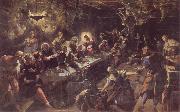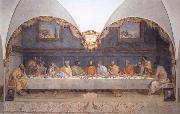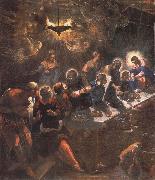
Oil On
Canvas, Real Flavor of Old Masters
|
Tintoretto
|
|||
|
|
|||
| Italian Mannerist Painter, ca.1518-1594 His father was a silk dyer (tintore); hence the nickname Tintoretto ("Little Dyer"). His early influences include Michelangelo and Titian. In Christ and the Adulteress (c. 1545) figures are set in vast spaces in fanciful perspectives, in distinctly Mannerist style. In 1548 he became the centre of attention of artists and literary men in Venice with his St. Mark Freeing the Slave, so rich in structural elements of post-Michelangelo Roman art that it is surprising to learn that he had never visited Rome. By 1555 he was a famous and sought-after painter, with a style marked by quickness of execution, great vivacity of colour, a predilection for variegated perspective, and a dynamic conception of space. In his most important undertaking, the decoration of Venice's Scuola Grande di San Rocco (1564 C 88), he exhibited his passionate style and profound religious faith. His technique and vision were wholly personal and constantly evolving. | |||
|
|
|||
|
|
The communion new12/Tintoretto-528832.jpg Painting ID:: 38515 Visit European Gallery |
mk137 1592-1594 oil on linen 365x568cm San Giorgio Maggiore, Venice | |
Height Width |
INS/CM |
||
|
X |
|
||
|
|
|||
|
ALLORI Alessandro
|
|||
|
|
|||
| Italian Mannerist Painter, 1535-1607 Born in Florence. After the death of his father in 1540 he was brought up and trained in art by a close friend, often referred to as his 'uncle', the mannerist painter Agnolo Bronzino, whose name he sometimes assumed in his pictures. In some ways, Allori is the last of the line of prominent Florentine painters, of generally undiluted Tuscan artistic heritage: Andrea del Sarto worked with Fra Bartolomeo (as well as Leonardo Da Vinci), Pontormo briefly worked under Andrea, and trained Bronzino, who trained Allori. Subsequent generations in the city would be strongly influenced by the tide of Baroque styles pre-eminent in other parts of Italy. Freedburg derides Allori as derivative, claiming he illustrates "the ideal of Maniera by which art (and style) are generated out of pre-existing art." The polish of figures has an unnatural marble-like form as if he aimed for cold statuary. It can be said of late phase mannerist painting in Florence, that the city that had early breathed life into statuary with the works of masters like Donatello and Michelangelo, was still so awed by them that it petrified the poses of figures in painting. While by 1600 the Baroque elsewhere was beginning to give life to painted figures, Florence was painting two-dimensional statues. Furthermore, in general, with the exception of the Contra Maniera artists, it dared not stray from high themes or stray into high emotion. | |||
|
|
|||
|
|
The communion new17/ALLORI Alessandro-475335.jpg Painting ID:: 45493 Visit European Gallery |
mk186 1582 Florence, Stanta Maria del Carmine | |
Height Width |
INS/CM |
||
|
X |
|
||
|
|
|||
|
CLEVE, Joos van
|
|||
|
|
|||
| Flemish Northern Renaissance Painter, ca.1485-1540 | |||
|
|
|||
|
|
The communion new17/CLEVE, Joos van-555468.jpg Painting ID:: 45497 Visit European Gallery |
MK186 around 1530 Paris muse you Louvre | |
Height Width |
INS/CM |
||
|
X |
|
||
|
|
|||
|
Tintoretto
|
|||
|
|
|||
| Italian Mannerist Painter, ca.1518-1594 His father was a silk dyer (tintore); hence the nickname Tintoretto ("Little Dyer"). His early influences include Michelangelo and Titian. In Christ and the Adulteress (c. 1545) figures are set in vast spaces in fanciful perspectives, in distinctly Mannerist style. In 1548 he became the centre of attention of artists and literary men in Venice with his St. Mark Freeing the Slave, so rich in structural elements of post-Michelangelo Roman art that it is surprising to learn that he had never visited Rome. By 1555 he was a famous and sought-after painter, with a style marked by quickness of execution, great vivacity of colour, a predilection for variegated perspective, and a dynamic conception of space. In his most important undertaking, the decoration of Venice's Scuola Grande di San Rocco (1564 C 88), he exhibited his passionate style and profound religious faith. His technique and vision were wholly personal and constantly evolving. | |||
|
|
|||
|
|
The communion new17/Tintoretto-269948.jpg Painting ID:: 45621 Visit European Gallery |
mk186 1592-94 Venice church San Giorgio Maggiore | |
Height Width |
INS/CM |
||
|
X |
|
||
|
|
|||










